9 Simple Ways to Write a Good Introduction Sentence

When I started my journey as a freelance writer, I struggled with writing introductions. I’d often find myself diving into the main body of the article and even wrapping up the conclusion before circling back to the beginning.
The pressure to craft an attention-grabbing opening was overwhelming, and I’d spend days trying to figure out the right angle. The reason is that intros have to be compelling enough to make readers continue.
They have to make a good first impression.
Compelling readers to read the article is an art form in itself. And if you don‘t do it well, you’re missing out on potential subscribers, leads, and customers.
In this post, I'll share some simple techniques that helped me write powerful introductions that turn casual browsers into readers. Article introductions matter, and here’s how you can make yours count.
Table of Contents
How to Start an Introduction
Writing a compelling introduction is crucial for grabbing your reader’s attention and setting the tone for your entire article.
While there are many approaches you can take to your introduction, here are three common but effective ways to start an intro that captivate your audience from the very first sentence:
1. Using Quotes
Starting with a quote can immediately engage your readers by introducing a voice or perspective that resonates with the theme of your article.
Whether it’s a famous quote, a line from a relevant book or movie, or a statement from an industry expert, a well-chosen quote can lend authority and context to your topic. It can also spark curiosity, encouraging readers to think about how the quote connects to the content that follows.
In the article, The Hidden Costs of Hobbies and Side Projects, the author, Sam, starts with an anonymous quote: “You have to sacrifice in life, or your life will become the sacrifice.”

While the article's title is somewhat worrying, the quote does intensify the ominous feeling readers will likely develop as they examine their own lives to see what their hobbies and side projects might be costing them and how detrimental these costs are to their overall well-being.
Another example of how quotes multiply the impact an article intro has on readers is this one in an article about the three deep books that rewired his mind.
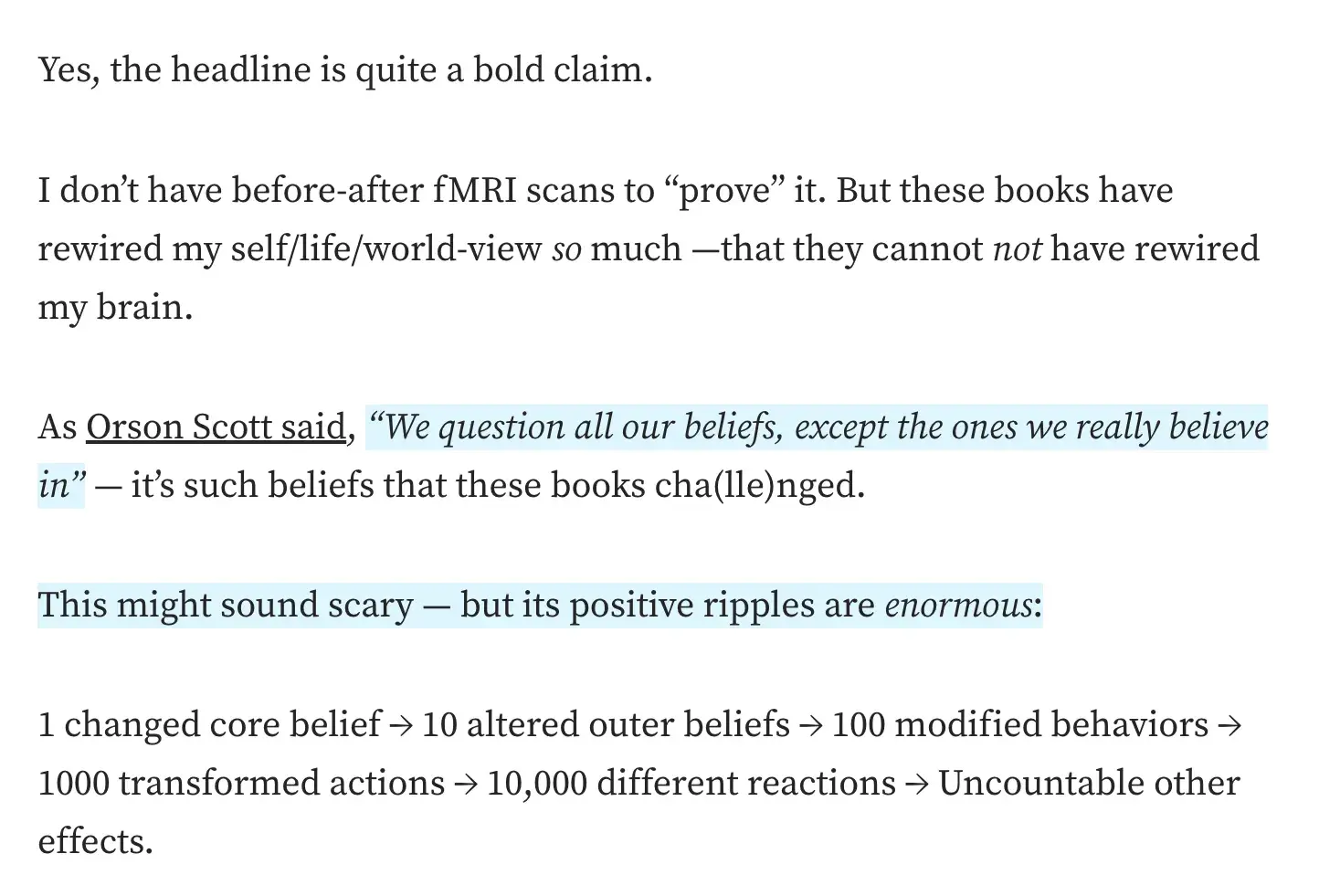
While the quote is not the first sentence in the intro, it does appear quite early: “We question all our beliefs except the ones we really believe in” by Orson Scott.
This quote carries emotional weight, provoking thought and stirring curiosity in readers. It makes them want to find out the titles of these books, how exactly they rewired the author’s worldview, and if the books can help them question their own deeply held beliefs.
2. Setting a Scene
Setting a scene at the beginning of your article can draw readers into a specific moment, place, or situation. This method is particularly effective for creating a vivid mental image that makes the topic more relatable and engaging.
By painting a picture with your words, you invite your readers to step into the scenario and experience it alongside you, which can make your content more impactful and memorable.
Here’s an article titled Your OKRs Aren’t OKRs. While business-related articles can be boring and monotonous, the author of this one infuses life and color into the piece by starting with a scenario.
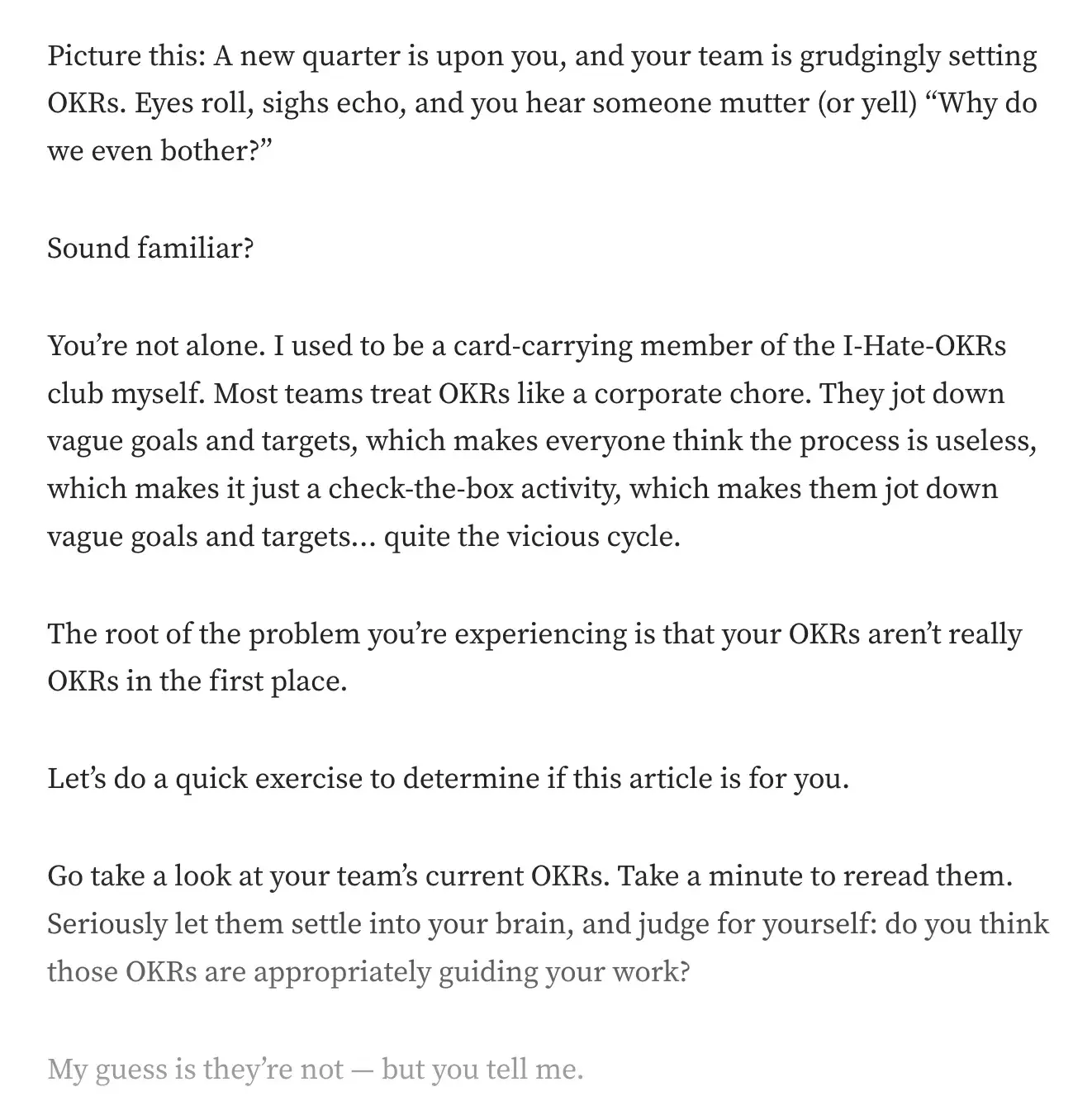
This scenario activates readers’ imagination, allowing them to “see” the context of the piece before consuming the main content.
It’s also written in a way that readers will likely be able to relate, especially as the author discusses their own former dislike for Objectives and Key Results (OKRs), showing that it’s something of a universal experience for managers.
When you set a scene, you’re not just describing a situation — you’re creating an atmosphere that evokes emotion.
Whether it’s tension, excitement, nostalgia, or calm, the scene you set can influence how readers feel as they begin reading. This emotional connection makes them more invested and more likely to continue reading.
Pro tip: Whenever I have a relevant personal or work experience to share (that relates to my article topic), I like to use my experience as the intro (as I did in this article). But instead of swapping one for the other, you can combine a fictional scenario with an anecdote to create a stronger impact.
3. Using Statistics or Fun Facts
Starting your introduction with a statistic or fun fact is a powerful way to grab attention by surprising your readers or providing them with a piece of information they might not have known.
This approach can quickly establish relevance and credibility, especially when the statistic or fact directly relates to the problem or topic your article addresses. It also encourages readers to think critically about the subject, making them more invested in learning more.
In this article about the benefits of eye contact, the author referenced a study by Intelligent.com that shows that over 50% of employers interpret a struggle to make eye contact as nervousness or a lack of confidence.
![good intro sentence example - using statistics: “According to a recent survey from Intelligent.com, more than half of employers… interpret [struggle to make eye contact] as a lack of confidence or nervousness.”](https://knowledge.hubspot.com/hubfs/how-to-write-stronger-introductions-4-20240912-8948634.webp)
This statistic achieves two things in this article. First, it educates readers who were not aware of this fact. Those who struggle to make eye contact, especially in interviews, will want to read the article till the end to figure out how to fix this issue and increase their chances of finding a job.
Second, it lends credibility to the piece and, by extension, the author. Instead of the author simply saying that not making eye contact can lead others to think one is nervous or lacks confidence, they find and reference an actual study to prove their point and emphasize the importance of eye contact in conversation.
Readers will more readily believe the study and other articles by the same author as they’ve seen that the author doesn’t pull claims out of thin air.
Fun facts might not be based on surveys, but using them in your intros is a, dare I say, fun way to quicken readers’ interest in your piece. The caveat is they have to be relevant to the topic you’re discussing.
Take, for example, this fun fact in the intro of an article titled, How Writing Makes The Invisible Visible (And Using This to Connect to Things Far Bigger).

The author uses the fact that octopuses can taste things (and thus, sample their environment) with their tentacles to draw a parallel to how writing can help folks “turn our complex worlds into structured language.”
Sure, this fun fact is great to learn, but it also provokes curiosity and helps readers think critically about the topic.
1. Keep it short.
I’m a big fan of short sentences. I love them because people can understand them easily. There's great value in short sentences that are readable, digestible, and punchy.

Writers often get so caught up in the pressure of a good intro that they deliver long, run-on sentences. The problem with these sentences is that they make readers work hard, which isn’t a great incentive to keep reading.
While the length of an introduction can vary, it’s best to aim for brevity with up to three short paragraphs. Using AI tools like our Paragraph Rewriter tool can help make your paragraphs more impactful and concise.
Readers are impatient to get to the meat of the article, so don't bury the lede deep in your article — cut to the chase.
A good example of a short intro is this one by Pablo Srugo for his article titled “I Was Supposed To Be a Millionaire at 25 … Instead, I Went Bankrupt.” The intro is just three sentences long and adequately complements the attention-grabbing headline, prompting readers to continue.

Another one is this listicle explaining the top 15 software development trends. The intro quickly explains why software developers must be aware of these trends and segues right into said trends.

2. Say something unexpected.
You‘ve probably heard advice like "Create a hook" and "Grab the reader’s attention." But what kind of stuff actually grabs someone's attention?
The trick is to say something unexpected — something that catches the reader off guard.
This could be a personal story that’s relatable yet surprising, a question that challenges assumptions, compelling data that shifts perspectives, or a scene-setting sentence that transports the reader into a different context.
Think about it — your reader has already clicked on the headline. So, they’re interested in your topic. But now, you have to reel them in a little further.
If your very first sentence is interesting enough to make people want to read the next one, then you've done a good job.
For example, this intro for an article titled “Absurdism: The Philosophy That Changed My Mindset” starts off with a thought that many people struggle with: Nothing good is going on in my life.

While this is a shocking way to start an article, it does communicate to readers that the author has been in their shoes and understands what they’re going through. And so, people who had never heard of absurdism before would be interested in continuing the article to see if there’s anything in it for them.
Here’s another example of a great intro, except this one sets the scene with a fictitious character named George, a recruiter whose job is to sort through thousands of resumes for new job openings.
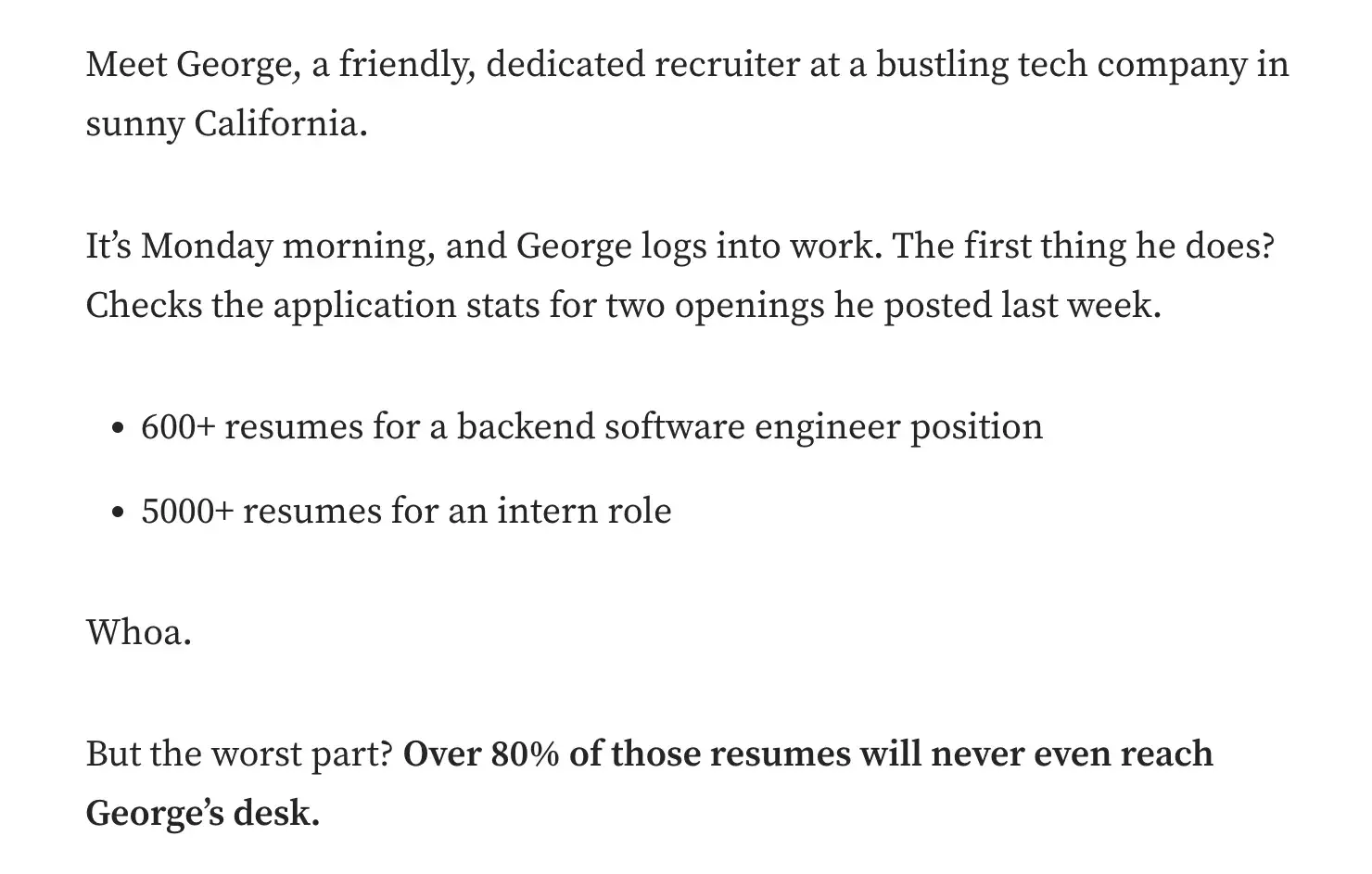
This scene helps readers picture an environment in which they’re key players. In this case, the character they’re relating to isn’t George but the candidates whose resumes get stuck in the Applicant Tracking System (ATS) and who wait for a response that will never come.
George’s character provides the necessary context for candidates to understand what goes on at the other end of their application once they’ve sent it.
3. Don’t repeat the title.
You only have a few seconds to make a strong impression in your introduction, so use that time wisely.
While repeating the title of your article in the opening sentence might seem like a natural way to start, it’s actually a wasted opportunity. Your reader has already seen the title and clicked on it because it intrigued them. Now, they’re looking for something more.
Instead of reiterating the headline, use your introduction to reinforce the promise made by the title and set the stage for the rest of the article.
This is your chance to expand on the topic, provide context, and highlight the value your content will bring.
4. Use the word “you” at least once.
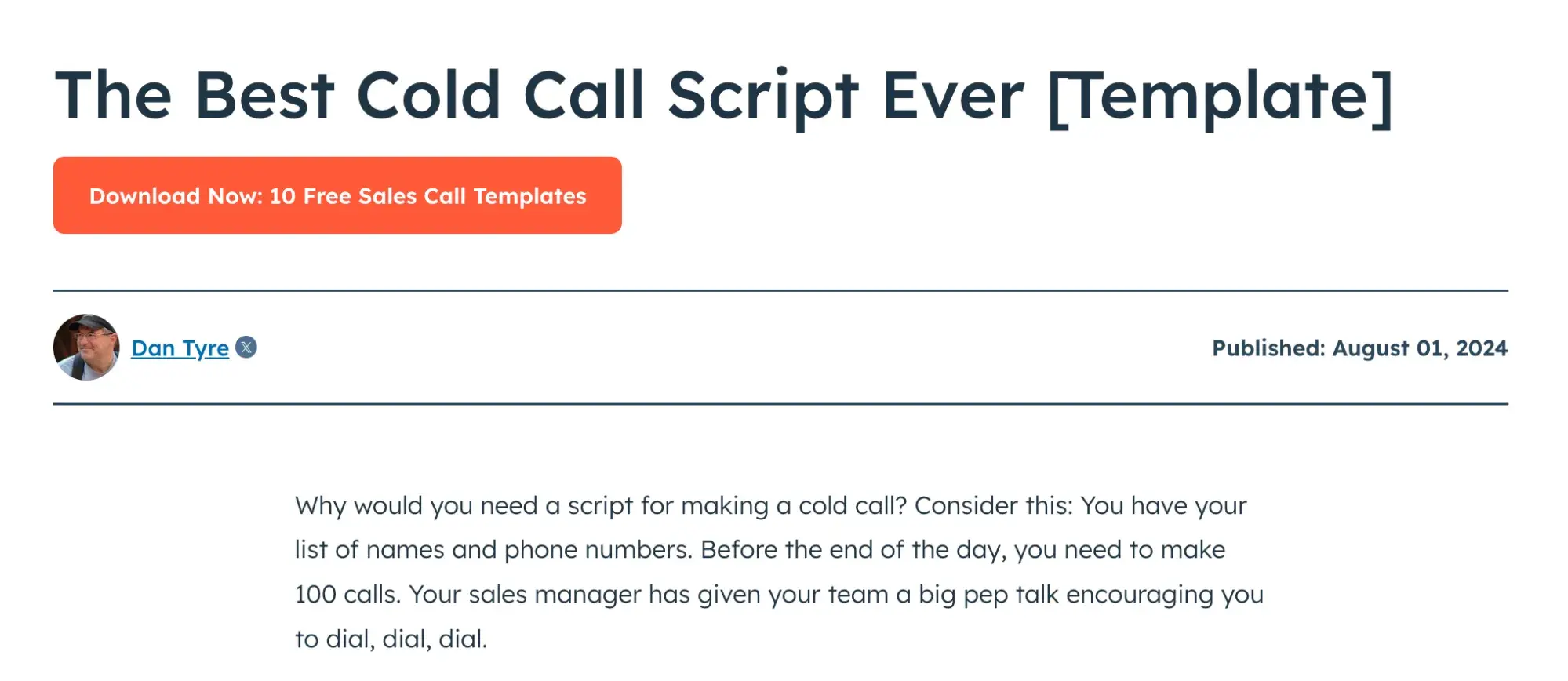
The word “you” is a powerful word.
It tells the reader that you, the author, are writing the article with them in mind. You empathize with them, you care about them, and you want your piece to resonate with them.
It's a simple trick that establishes a crucial connection with your reader. It can transform a piece of writing from a distant, impersonal narrative into a conversation that resonates with the reader on a deeper level.
I’m using this technique in this article itself.
After discussing my experience struggling to write introductions, I explained to you, my readers, why knowing how to write compelling introductions is important and how these techniques will help you write better intros.
5. Tell readers what's coming next.
As you craft your introduction, guide your readers by letting them know what they can expect from the rest of your article. What will you be covering? What will the reader learn? How will this help them?

By answering these questions in your intro, you set clear expectations and help your audience navigate your content. They might just jump to the section they’re most interested in or read the whole thing. Here are a few examples:
- “You’re about to find out why sea turtles always lay their eggs on the beach.”
- “And, if you’ve ever wondered why sea turtles lay their eggs on the beach, here's everything you need to know.”
- “This article explains the 17 reasons why these amazing creatures lay their eggs on beaches.”
- “Fascinating, funny, and shocking, these are the reasons why sea creatures lay their eggs on the beach.”
But you don’t always have to be so explicit. Sometimes, a well-placed question is enough to help readers infer that you’re about to give them some good information or tips in the article.
Here’s an example of this from a business article about handling a low performer:
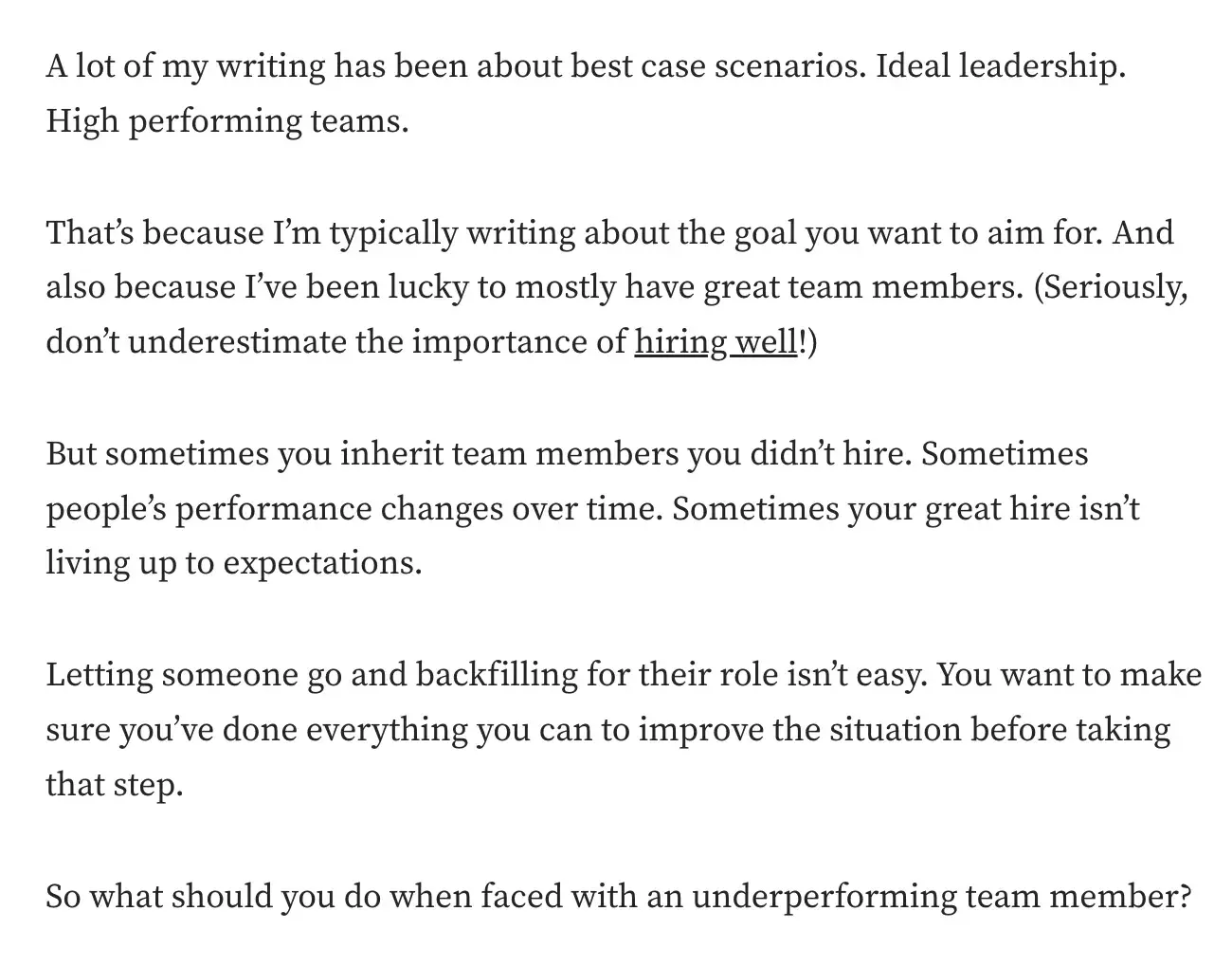
After explaining how managers often inherit team members they didn’t hire, and some don’t meet the company’s expectations, the author asks, “So what should you do when faced with an underperforming team member?”
The presence of this question implies that the author will answer it in the main body of the article, so readers know to look forward to it.
6. Explain why the article is important.
It may be obvious to you why your article is important to your readers, but it’s up to you to emphasize its value and put it in context.
For instance, say you’re writing an article about TikTok written for a marketing audience. You could lead with a surprising TikTok stat about its user base. Here’s an example:
“In the past two years, TikTok’s user base has grown by 15% while other platforms are seeing stagnant or declining engagement. This suggests that marketers may want to pay more attention to this short-form video platform.”
In two sentences, you’ve presented an interesting tidbit and explained why it matters.
Take the introduction to this article. You'll recall the following sentence: “And if you don‘t do it well, you’re missing out on potential subscribers, leads, and customers.”
My goal here was to connect the topic of blog post introductions to a business’s bottom line.
This article by Rakia Ben Sassi about starting a YouTube channel does something similar:
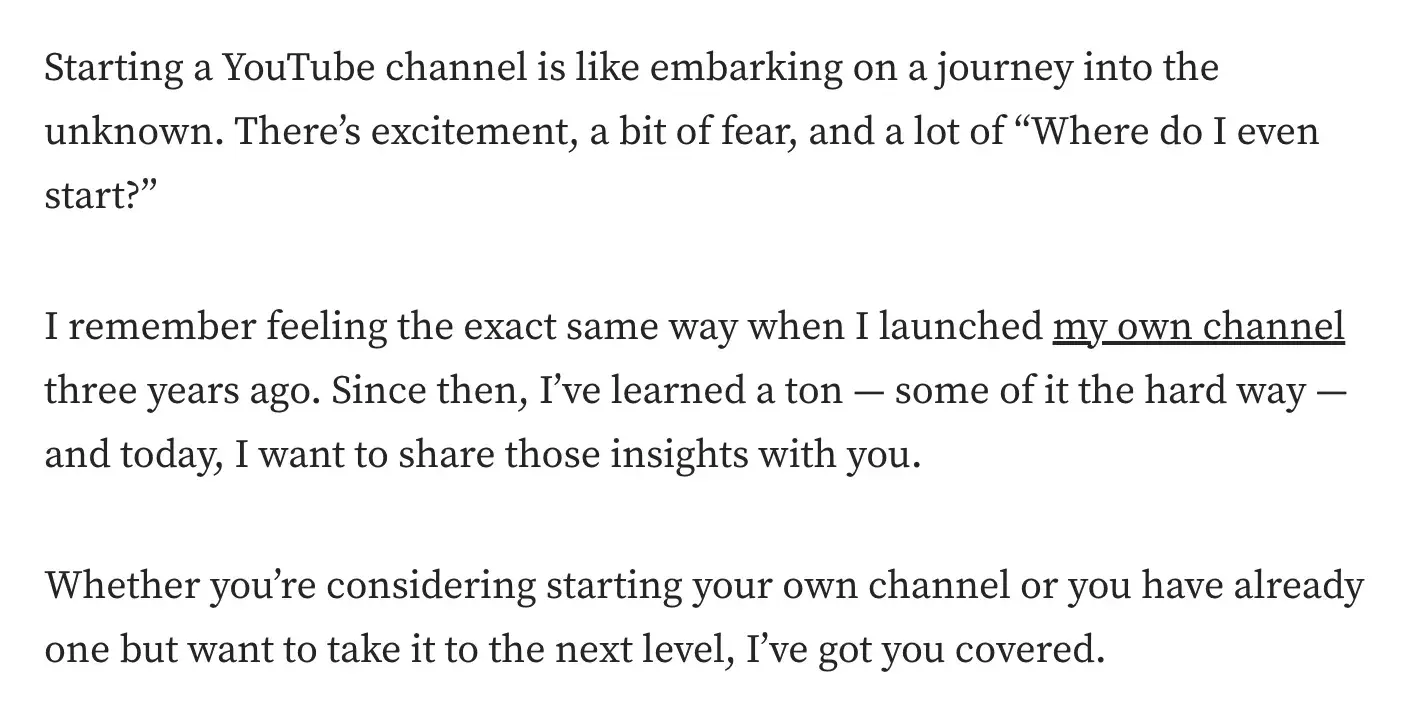
She sets the stage by describing the fear, excitement, and uncertainty people feel when starting a YouTube channel. Then, she talks about her credentials and why readers should trust her opinion (she launched her own channel three years ago).
Then, she explains why the article is important: It’s to help readers who are starting a new channel or trying to scale an existing one.
7. Refer to a concern or problem your readers might have.
Everyone in every field has their own set of problems. You should have some listed already from when you created your buyer personas.
Addressing a specific concern or problem your readers face is a powerful way to engage them right from the start.
By acknowledging their challenges, you show empathy and immediately establish the relevance of your content. People want to solve their problems, and articles that explain how to do this will help you earn readership.

For example, if you’re writing an article explaining how digital marketers can keep up with the ever-evolving digital landscape, you could say: “Feeling overwhelmed by the constant changes in digital marketing? You’re not alone. In this article, we’ll explore strategies to help you stay ahead without burning out.”
This empathetic approach helps you build trust and credibility, as it demonstrates your understanding of your readers’ needs. When you tap into the reader's problem-solving mindset, they’re motivated to continue reading in search of solutions, making your content more impactful and memorable.
8. Be careful telling stories.
Many people will tell you that you need to write a story in the introduction to captivate your audience. Stories can be a powerful tool to draw readers in, as they naturally spark curiosity and create an emotional connection.
However, there are both good and bad ways to use storytelling in your introductions. The key is to tell a concise, relevant, and compelling story that piques your readers’ interest without overwhelming them with too much detail.
While it’s tempting to delve into a long and intricate story, remember that an introduction aims to grab attention quickly and set the stage for what’s to come. A long-winded story can lose readers along the way, diminishing the impact of your article.
If you choose to begin your article with a story, consider withholding the conclusion of that story until later in the article or even until the very end. By delaying the resolution, you create a narrative thread that weaves through your article, maintaining your readers’ interest as you build up to the story’s conclusion.
For example, say you’re writing an article about overcoming challenges in entrepreneurship.
If you’re an entrepreneur yourself, you might start with a short anecdote about a time you faced a significant setback in your entrepreneurial journey.
Describe the struggle you faced and how it seemed insurmountable at the time, but don’t reveal how you overcame it just yet.
Instead, use the story to illustrate the theme of resilience and promise your readers that you’ll explore how you turned things around later in the article.
9. Use a stat or a fact to convey urgency.
When journalists begin a news story, they often give readers an eye-catching stat or fact about what's going on.
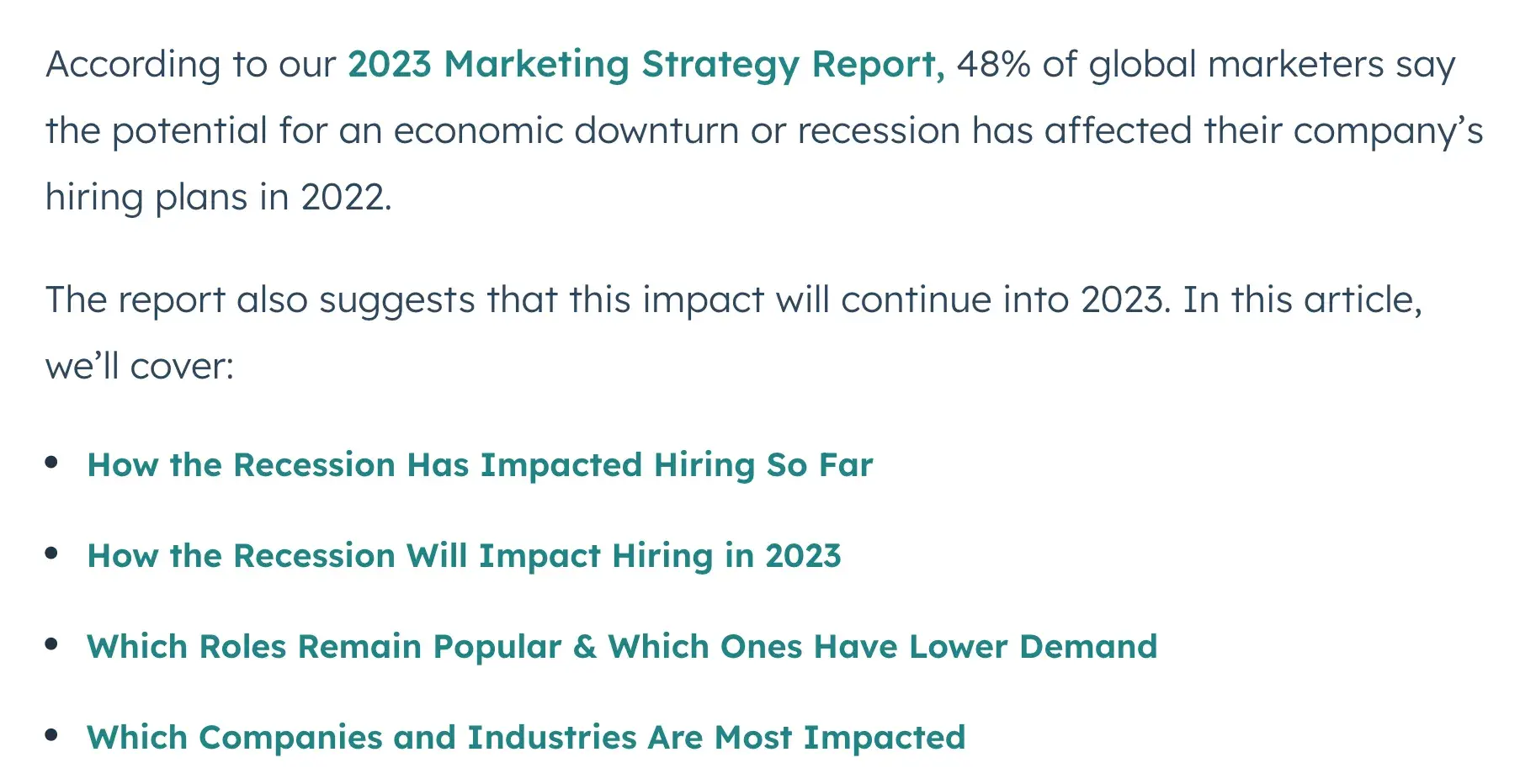
As a blogger or any type of writer, a really interesting stat or fact will draw your reader in and show them why your topic is really important.
For example, say you're a plumber writing a blog post on pipe replacement. You might pull in more readers if you start a post by explaining how frequently old pipes burst in the winter.
Or, if you’re writing an article showing folks how to spend more time reading instead of scrolling their phone screens, you can start by sharing statistics on how many hours young people spend on their phones daily. Like this:
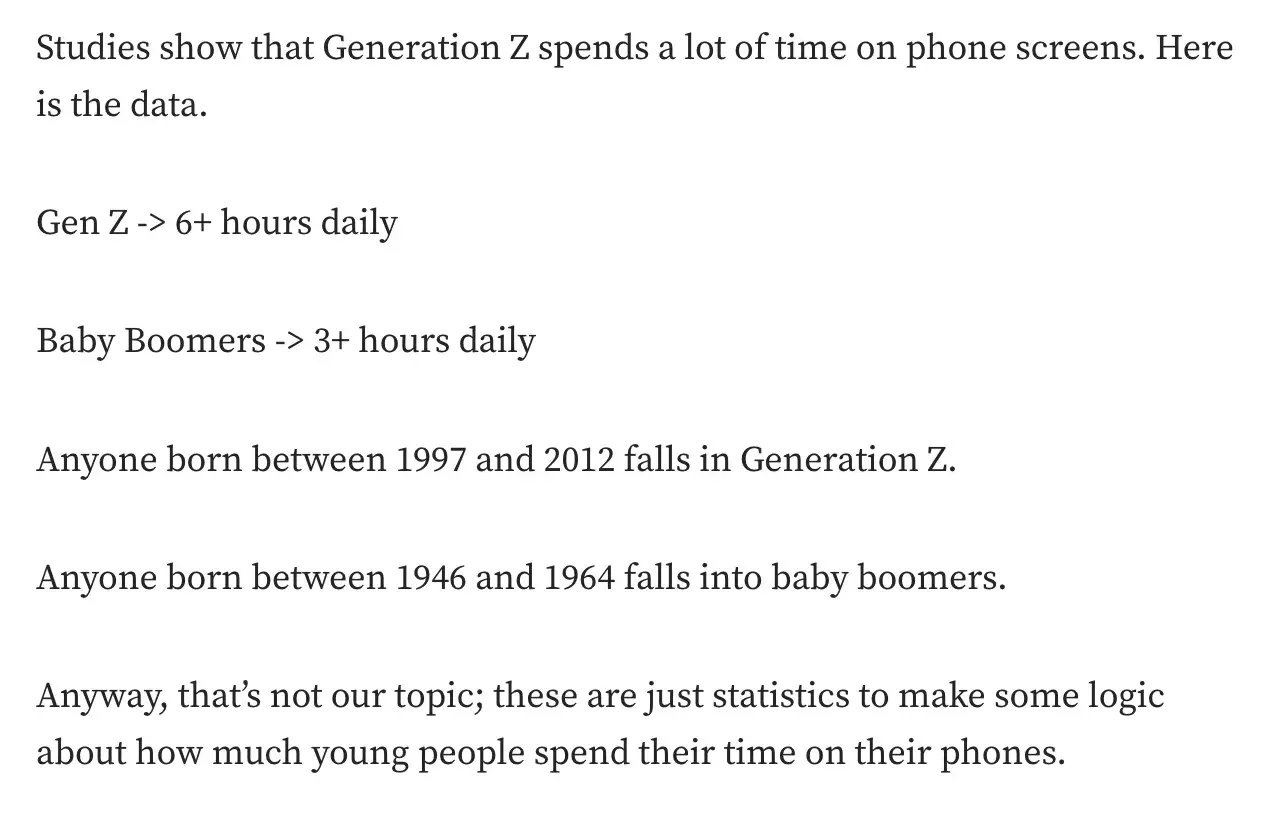
If readers see that this is a common issue that others face, they might keep reading to learn how they can avoid it.
Using Generative AI to Write Content
ChatGPT’s instant and massive popularity in late 2022 heralded serious discourse about using generative AI to write content.
While there are some polarizing opinions on how generative AI should be used, there’s no denying that AI tools like ChatGPT, Jasper, and Copy.ai have become valuable tools for content creators, including myself. These tools help writers brainstorm ideas, overcome writer’s block, and generate content drafts.
In my experience, they speed up my writing process by providing a starting point, crafting compelling introductions, and suggesting alternative phrasings.
However, while generative AI can be incredibly helpful, I don’t think you should solely rely on what it generates. AI tools can produce coherent and well-structured content, but the output often lacks the depth and nuance that come from personal experience, deep research, and subject-matter expertise.
Moreover, AI-generated text may include inaccuracies or “hallucinations” — instances where the AI presents false or misleading information as fact.
In this article, the team at IBM detailed a few examples of AI hallucinations, including the time Meta pulled its Galactica LLM (large language model) demo in 2022 after it provided users with inaccurate information that was sometimes rooted in bias and prejudice.
This is why you should always fact-check anything AI generates for you.
That said, you can use AI as a starting point in your writing process and then refine the content with your own (or third-party) expertise to create an engaging and trustworthy piece. If you struggle with intros, here are the steps to using AI to craft article introductions:
- Determine the type of introduction you want to create. Are you starting with a fun fact, a quote, or by setting a scene? Each approach requires a different prompt.
- Next, write a prompt that instructs the AI on what kind of intro you need. Be clear about the tone, style, and content you’re aiming for.
- Once the AI tool generates the text, read it carefully. Look for any inaccuracies or areas that might need clarification, restructuring, or additional detail. The AI’s output is just a draft; it’s up to you to refine it.
- Edit the AI-generated content to incorporate your own knowledge, experiences, and voice. Make sure the introduction aligns with the rest of your article and provides an engaging start.
- Verify any data, quotes, or facts included in the AI-generated text and personalize the content where necessary to ensure it resonates with your audience and reflects your unique perspective.
Here are a few examples of AI prompts for different intro types.
1. Stating a Fun Fact
Prompt: Write an engaging introduction for an article about the benefits of morning exercise. Start with a surprising fun fact about how exercise impacts mental health.
Possible output: Did you know that just 20 minutes of exercise in the morning can boost your mood for up to 12 hours? In this article, we’ll explore how a simple morning workout can set a positive tone for your entire day.
2. Using Quotes
Prompt: Create an introduction for an article about leadership in the workplace. Start with a powerful quote about leadership from a well-known figure.
Possible output: “The greatest leader is not necessarily the one who does the greatest things. He is the one that gets the people to do the greatest things.” This quote by Ronald Reagan perfectly captures the essence of leadership. In this article, we’ll discuss how great leaders inspire their teams to achieve extraordinary results.
3. Setting a Scene
Prompt: Write an introduction for an article about the challenges of remote work. Start by setting a scene that highlights a common struggle for remote workers.
Possible output: It’s 7:00 AM, and you’re already answering emails from the comfort of your kitchen table. The line between work and home blurs as you sip your coffee, trying to find focus in a space that was once reserved for relaxation. This is the new reality of remote work, where the challenges are as complex as they are unique.
Note: If you find it difficult or time-consuming to write a whole blog post from start to finish, check out HubSpot’s free blog post templates that help you save time without compromising on quality.
Making a Great First Impression
While setting a scene and/or sharing a relevant anecdote is my favorite way to start an article intro, I learned — and I hope you did, too — that there are several ways to write an introduction that packs a punch and prompts readers to read till the end, including using quotes and sharing fun facts.
However, while these techniques are excellent for creating interest, over the past couple of years, I realized that what really keeps people reading a piece is the empathy I, the author, infuse into it.
Letting readers know that I know and relate to their struggles and that I have a possible solution for them, be it an alternative way of doing things or a contrarian idea to help them broaden their epistemic horizons, is what keeps them engaged.
So now, whenever I write an introduction, I think about what kind of introduction would make me want to read the article. I then use that to inform the approach I take.
Introductions are hard, and writing effective ones takes time and practice. But remember, it's all worth it if it means keeping the attention of a few more of your readers.
Editor's note: This post was originally published in October 2015 and has been updated for comprehensiveness.
Comments
Post a Comment